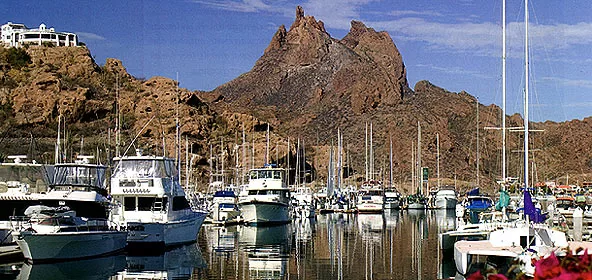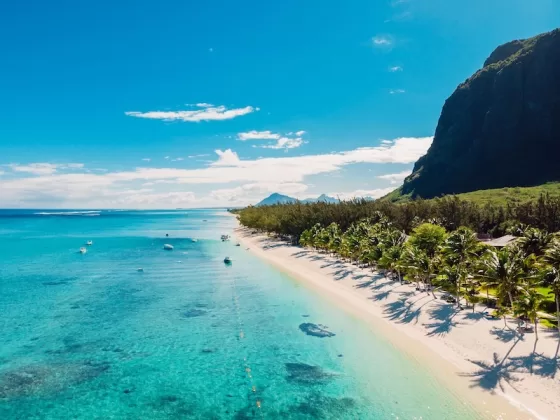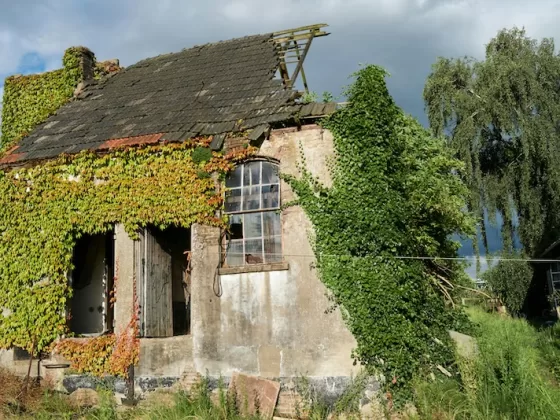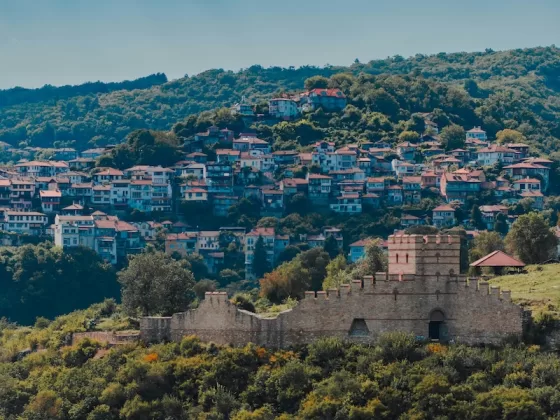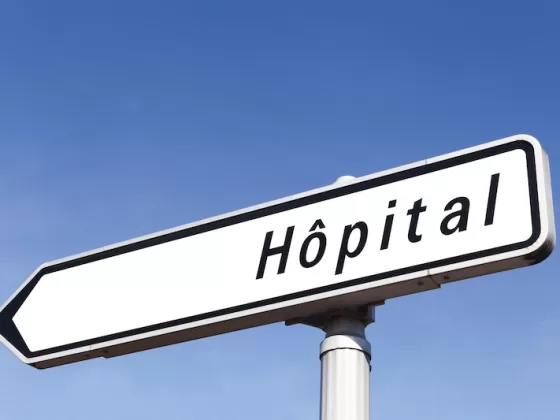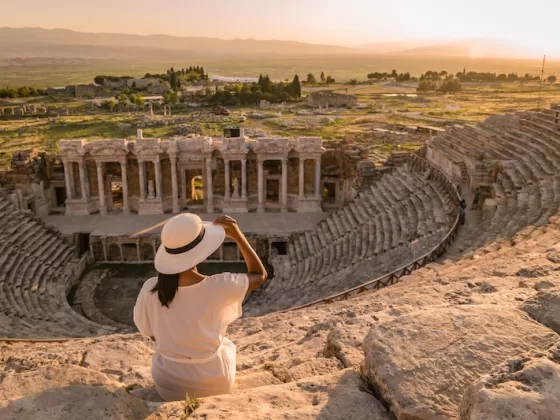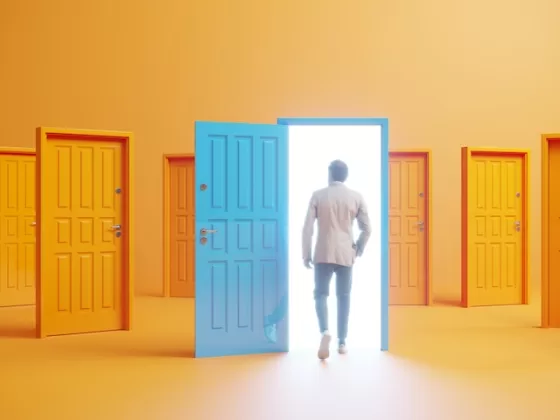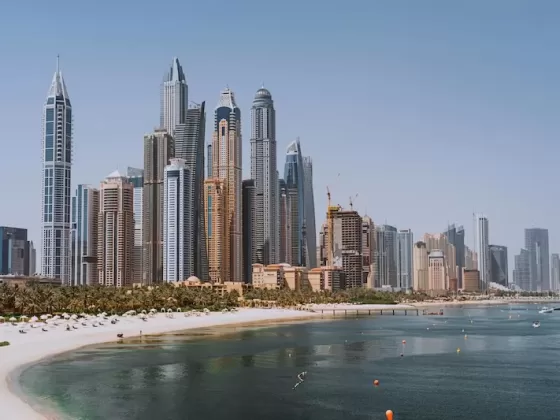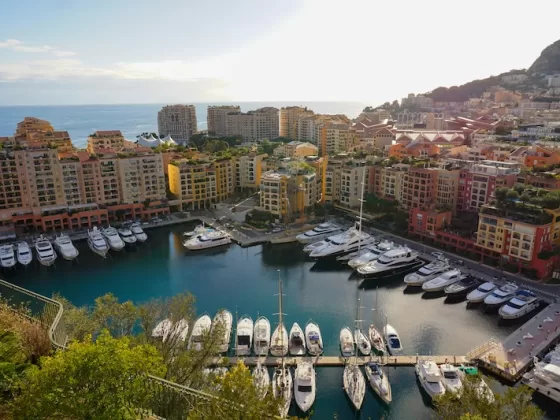As the bus sped north to Boston, the trees and walls, strip malls and cell towers, glided past. The bus made good time in spite of four stops. Travelers exited the bus occasionally, but most passengers were headed to Boston. I glanced at my fellow passengers and wondered how many of them would fly to Ireland with me.
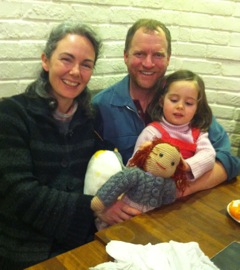
Traffic increased dramatically after the town of Hanover. When the bus approached the Braintree split; where Route 3 from intersects routes 128 and 95, the traffic increased from heavy to massive. The bus entered the special HOV speed lane, and moved past three lanes of traffic, but not very fast. Stop and go, stop and go. We approached South Station.
Built in 1899 at a cost of three million dollars, South Station has always
impressed me with its narrow winding turns, fine for Model T Fords, but dizzyingly labyrinthine for large modern buses. About ten people stepped off the bus to make connections to New Hampshire or New York City, or subways to Cambridge. Then the folding doors closed.
Downward and outbound, we spun around turns as treacherous as Medieval stone stairways. Three minutes later we found ourselves abruptly rounding the speedway hills and twists of Logan International Airport. As each small group got off at different terminals, I noticed how many travelers stayed on the bus to take international flights. I tried to perceive those going to Dublin.
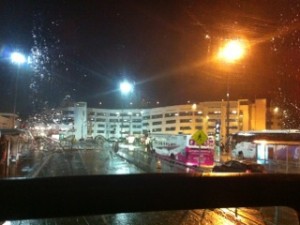
We entered the International Terminal and the crowd left on the bus immediately dissipated. The terminal appeared empty for flights to Ireland. I had arrived three and a half hours early. I hate to be late.
So I avoided the sparkling stores and colorful magazines and checked in with Aer Lingus. I was focused on the boarding pass that I was not allowed to download the night before my flight. I wanted to make sure everything went smoothly.
Allowed twenty-two pounds, I had purchased a new and larger suitcase, four pounds rather than seven in the old suitcase. Since it was a carry on suitcase, I wouldn’t have to wait for it to be unloaded in Dublin. But it was one more thing for which to be alert and responsible.
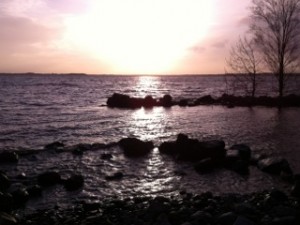
There seemed to be no way to get upstairs for the security check. The elevators didn’t work. Rushing people gave me directions. “Go left at the flags”.
It took six minutes for me to locate the escalator. I dragged my suitcase onto the narrow moving stairs, while putting my pocketbook back into the weightless and much pocketed shoulder bag.
When the escalator ended I popped onto the privileged departure level, where teeming people wandered around killing time. I needed to get out my passport and ID, which were now safely back in the zippered bag compartment with the boarding pass.
Two hours to go.
Up here there was hectic activity, most involving identification and security checks. A gallant Chinese guy put my suitcase on the conveyor for me. He kept motioning for me to do nothing. But the security people made him stop and eyed him suspiciously.
Was my money in the pocket of the suitcase?
My jacket, boots, pocketbook, journal and cell phone were placed in a basket. I tried to keep an eye on the suitcase, while I went through the invasive x ray machine, glad I had not worn an underwire bra.
The passport and ID had to be presented four times altogether. It proved difficult to lug my carry on, while getting out the passport without losing it.
I cursed the new suitcase.
Shoes off, shoes on. Jacket off, jacket on. Passport out, ID out, boarding pass out. Remember where you put them.
The only stores on the other side of security were duty free liquor, chocolate, and perfume at exorbitant prices. I’d buy a gift for Tess later. I already had the star slippers and warm weather blouse for her. I gave up trying to navigate the halls, and sat down for a wine sampler. Use the middle first, the right second, the left last. Good. I like a little ritual and it was nice not to have to present identification for a minute.
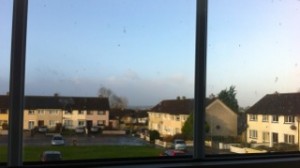
Nearby, a large crowd was assembling for the non-stop flight to Shanghai. They were happily chatting in Chinese dialects. I wish I understood the languages. I noticed there was not a non-Asian among the crowd.
I watched a tiny girl in a gold and furred Chinese vest taking running steps, her mother in hot pursuit. Non–stop to Shanghai! How long would that take?
After my three red-wine sampler, ladies room visit, and store tour, I wandered down to the Aer Lingus gate and sat down. I was now surrounded by another talkative crowd all going to Ireland. And yes. Some of them had been on the bus.
One and a half hours to go.
The plane began boarding early. Then boarding stopped. The staff discharged those already on board. Mechanical issue. Twenty minutes passed, and they began boarding again. I needed to take out my passport again. After we were finally seated, a few people had to show their passport once more.
I passed the six-hour flight to Dublin watching Artists of the Riviera and an Irish documentary on the Foxford Woolen Mills of North Mayo. I was wistful for the less Puritanical days of smoking and live music of twenty years ago.
When the plane approached Dublin airport the winds were so fierce we could not land, and circled four times. Circle down and up, down and up, down and up. The plane grew silent, except for noisy wings and body. On the fourth circle we landed, everyone clapped quietly.
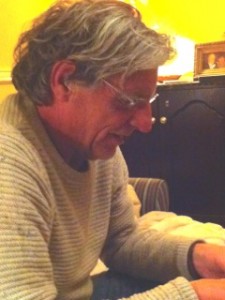
It was early the next morning but still dark.
Beyond the stationary airport were high winds, pouring slashing rain, and no posted directions to the bus area, located outside through transparent plastic tunnels. At the end of the fifth tunnel, I ran straight into the rain and ran from bus to bus asking if the drivers knew where the bus to Galway parked.
Two did not, but luckily the third driver escorted me to the Galway bus in the driving, cold, windy, water. Unlike him, the driver to Galway was taciturn and rude. Apparently did not like Americans, his job, or tourists. Whatever. I had accomplished the first leg of my journey.
I paid him the twenty-eight Euros and took a seat on the upper front of the two-decker bus.
Bureaucracy over, adventure on, in technicolor and wide screen!
The bus sailed out of Dublin International Airport in the early morning darkness and rain. I was awed by the massive colored lights on dramatic new buildings and tried to get some pictures.
Our first stop was in south Dublin, where four American students stood in the pouring rain waiting for the bus to Galway. Their cheerful chatter became somewhat cowed by the deadpan bus driver. So much for Citylink. I prefer Bus Eireann.
My best friend, Tess, met me at the bus station in Galway and we sped through the little streets. I reoriented my perception to register driving on the left side of the road, while sitting on the right side of the front seat.
At her house a stew was cooking in a large, round, quilted and insulated, container. Start the stew and then place it in the container. It “cooks” in the container until ready, a few days. Ancient ways are alive. Her entrepreneurial friend has started a business making and selling the cooking containers.
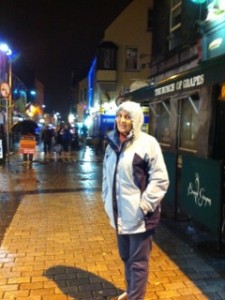
Friday night we went to the movies. Theatres show the same movies as in the States, although there are scathing critics in Ireland. But yes, we agree. Trash. Stupid. Like what is the point of Dirty Grandpa? Dementia is alive and well in Tinseltown.
There was also a live Opera on another screen, so they were giving out wine, a glass of which I took to my seat. We saw Spotlight, about the recent scandals in the Catholic Church. The audience was packed and silent.
On the way back, we picked up some convenience store food, and spent the rest of the night by the fire. We talked until bedtime at eleven, when I fell into a deep sleep to the sound of the fierce winds and staccato rain thrashing the casement windows. The weather rocked me to sleep like a ship on the Tyrrhenian Sea.
The next morning when I opened the curtains looking north, the pale yellow houses to the east were sparkling lively with golden color from the west. The view reminded me of Malta, known for its golden yellow buildings.
Wait! Wrong direction. How could houses looking west reflect a pale yellow sunrise? Eventually I figured out that sudden light on Galway Bay was reflecting back on the houses. Galway Bay, known for its five hundred swan pairs. Magic. Was this real?
It was Saturday, so we went into Galway city on a mission to have
adventures. We parked on the quai and headed for the flea market at Victoria Hotel Vintage Market. I was hoping to find real silk vintage pajamas. Amazing what one looks for abroad.
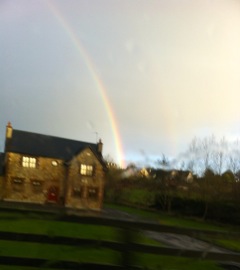
Most of the vendors were artists and crafters, or hailed from Eastern Europe. The Eastern Europeans traipsed from country to country picking up amazing things and selling them along the way.
Tess bought me a small bisque doll from Hungary for three Euros. I bought a large hand crochet doll for Silin (Sheeleen), Tess’s granddaughter. We were to meet her family later for lunch at the Aquarium in Salt Hill. I purchased the Autobiography of Ben Frankin for a reader I know, wondering about the guy who had read, and now sold the book.
No silk lingerie.
I love the little streets in European cities. One can stroll and look, and buildings are nestled close. In the chill soft rain we headed to the weekly farm market at St. Nicholas church through the cobbled main thoroughfare. Galway streets were lively in spite of the windy cold precipitation. The town was active with music, cafes, wine bars, begging, teens, and the occasional water protest and Atheist tables.
People looked familiar, the look of Bostonians.
Out of curiosity I picked up some atheist literature. I Googled the group, and found it is a very serious organization, which has gone before the UN with their concerns, mainly that religion is being forced down Irish kid’s throats through the education system. They want ethical secularism and reason. I think that was what the leaders of the French Revolution wanted, and that got quite unreasonable. But I dislike all kinds of dialectics.
We continued to the market fair at St. Nicholas Cathedral. The fair has been held on that spot every Saturday since the 1300s, when farmers began to bring food to sell to the workers building the cathedral. In the stalls were all manner of inexpensive but well-made things. I bought a very blue hand-made scarf and two Provence garlic pottery dishes, fashioned for ginger also. There was food, cheese, coffee, tea, textiles, pocket books, sculpture.
We entered the Gothic cathedral, desecrated by Cromwell’s army, which stabled horses in the church. In an act of iconoclasm they knocked off heads of angel sculptures on the pillars and tore up the graves of ancient Irish saints in the church graveyard, scattering the bones so they could not be identified and venerated. Think ISIS.
Organ music sounded while the choral group of Cor Mhaiegh Eo rehearsed. St Nicholas is a church built for this experience.
We ambled around the church and received an impromptu and incorrect history lesson from a woman who told us the angel heads were smashed off by the Black and Tans, during the Irish revolution. She was off by four hundred years and Tess pointed that out to her. But her sympathies were the same. “Oh I don’t know. It was those English though,” she replied.
We drove to meet Tess’s family at the aquarium for a wonderful home cooked meal. The little girl Silin, Cherry Blossom, loved the crochet doll and immediately began to take off the doll’s clothes.
“She likes it,” said her father.
February 1 is St. Bridget’s Day if you are Catholic. If not, it is Broch Bridge, half way between the December solstice and March equinox; explained Sabina, Tess’s daughter, who has worked in Celtic centers. In the olde religion this was Imbolc. People are unclear how Imbolc was celebrated, but it signals that Spring is near.
Bridge was known for her amazing cloak, which showered grace for the coming year. Sabina mentioned that in old times a piece of red or blue textile was left outside in the bushes for this happening. If it was put around your head the cloth relieved headaches. “I want to do it,” I exclaimed.
That night I left out a silken red cloth from Tess’s recent trip to India. It was pouring out, yet the cloth was untouched in the morning. I’m sure Bridge came by. I had no headaches in Ireland.
Always alert to stop drug abuse the US government might try this method to the use of opioids.
After lunch we drove home and fell asleep for a few hours, then awoke, ate stew, put on a turf and charcoal fire, read, then watched the Late Late Show. This is a TV program in progress since the inception of TV when there was only one channel. But the program is still fun to watch. Think 1950s in Maine, when you could only get the channel from Canada.
Up to bed at eleven. I read in For God’s Sake, by Camillus Metcalf. She examines the personal stories of ten nuns of different ages who had spent their lives in religious orders and how things their lives have been altered.
Outside it was still stormy with lashing water and rattling casements. I slept as if a night on a mountain, above all noise but nature.
Sunday. Now what mischief could we get into today?
We went to The Crane, a local pub on an off street, for an afternoon of Irish music sessions. In addition to the musicians and singers gathered in the corner, people at the bar or at the tables would suddenly start impromptu singing, or the recitation of personal poetry.
In Ireland there is no hurry to get patrons to leave the pub and give up their seats, so one can enjoy an afternoon with a beer.
We chatted with local DJ Mack who got into a long defense of Cromwell. “He was just trying to help the little people, not the aristocrats. Who’s history are you reading?”
Sunday night we curled up by the fire and read, until playwright and actor, Jerry Conneely joined us for a night of laughter and talk. He was acting in The Great Push, about the trenches in World War I, and has written another play about Irish freedom fighter Michael Davitt. That night we stayed up and laughed until two AM.
Michael Davitt, opposed to child labor and in favor of land reform, was a leader in Fenian Uprising, and was imprisoned for seven years, mostly in solitary confinement. After his release Davitt returned to his politics but was admitted to British Parliament and became a world traveler for human rights.
Jerry hails from a small fishing and boat building area in Connemara, where fishermen fashioned boats according to their own needs. Later when outsiders began to come in with the media business they spoke to one local man about his boat. They thought incorrectly that dimensions used by the fellow were the dimensions of all Connemara boats. So that is now how the famous boats from Connemara are now fashioned. He spoke of the burgeoning movie and TV business in the West of Ireland, and the Late Late Show.
The next morning we left Galway at 9:15 and drove to north Mayo, on off-highway roads. We thought it would be easy to locate Straide, the village where Michael Davitt is buried and where there is a museum devoted to him. But there were no signs, so we wandered around north Mayo and chanced upon the Foxmoor Woolen Mills, which I had seen on the documentary on the plane.
Eventually we located a sign and headed toward Straid, but there were few signs as we traveled. We later found out that in fact there were heated discussions in progress over whether or not to increase traffic by making it easy to find the museum.
When we finally located the it, the museum staff was most accomodating, had an expert discussion with Jerry Conneely, served us tea.
Although, Davitt was raised in England he is buried with his grandparents in the little cemetery in Straide. In America our family graves are spread all about the country in the places where our families trekked on their paths to work. I have missed the family plots with relatives, a thread through time. I wandered through the old cemetery and felt the ages looking up at me.
On the way back to Galway we suffered through heavy two-lane traffic as people left the city. I thought it was not too bad compared to traffic in the States. Also, Jerry amused us with many funny stories as we traveled. Among his less intellectual pursuits, the Conneely, as he likes to be called, is a great raconteur comedian and master of dialects.
That night Tess and I went to bed at nine and prepared for our trip to Cavan the next day. The wind and rain had been lashing us for days, but all was warm and serene, and I hardly cared.
Cavan is in the Midlands. It is the original homeland of one branch of my family. Its whereabouts were covered by a fog of the nineteenth century, and was unknown to us for one hundred and forty years. That may seem long, but it is only a few generations, and I note that we can be lost to time or linked through time. However, with computers and a little legwork there are revelations to be made. I found the missing piece. I wish my father were alive.
The car headed north to Mt. Nugent on the shores of Lough Sheelin. Giving up on the GPS we fell back to a paper map. We passed through villages like Tang, which means the language, and Granard. Tess had never heard of them. We always took lefts, trusting the paper map, although there was no signpost for Mt. Nugent. Mt. Nugent had been Dalysbridge before the powerful Nugent family took over. But Dalysbridge was not on the signs either.
The countryside ran through well-tended homes and fields, grazing cows and sheep. Rainbows hovered over the cottages as the driving rain paused. A wrong unmarked turn brought us down small roads, tucked between hills, known only to local farmers, but auspiciously shown to us. These byways eventually wandered back to the main road, but still directions to Mt. Nugent. Was this like navigation in the old days?
All of a sudden Mt. Nugent appeared at the bottom of another sign for small villages. We took another left. Gradually we journeyed into the area, and I began to see a family name on large chimneys, buildings, and trucks. Some of our people were still in the area, and doing quite well. I felt serenity in my chest. Who knew it would be like that?
We began to use the GPS again and located our hotel for the night. Once the palatial home of a British landlord or member of the Irish ascendancy, it was now the location of golf games, lavish weddings, and fishing in Lough Sheelin. February is off-season, and the hotel was affordable at 80 Euros.
We had arranged to dine there with the local priest in hopes he might know something about my family, but he was new to the parish and knew nothing. He was also hungry. We passed a convivial meal speaking of vocations and other concerns.
I took a picture of St. Bridget’s church built in 1820, and I reasoned my folk must have attended there, to church across the fields. No one knew where Kilbride, the exact Catholic area of Mt. Nugent was. Kilbride means Bridget’s Woods, and is still somewhere hidden in the woods and hills.
A man parked at the convenience store in Mt. Nugent said Kilbride is located down a winding little road in the northwest direction. He said it was easy.
We could not locate it, but we did drive around the area. It had to be in the hills overlooking Lough Sheelin, and known only to the locals from older generations. But it had to be in the northwest hills overlooking Lough Sheelin. I was there even if it wasn’t marked.
I wondered what had caused people to emigrate to America, to its tenements and mills, low pay and dirt. How bad had it been? My people were lace makers, a specialty needed in US textiles mills.
The rest of the story is a sad one and I won’t tell it.
I knew they wanted an adventure. That’s in the blood.
Someday I will return to Mt. Nugent, before it changes too much. Much of the fishing in Lough Sheelin is undergoing change. The trout in the lake are dwindling and being supplanted by pike, not enjoyed for eating by the local people. There is also an infestation of snail.
The land is being sold off. There is a land parcel of one hundred and thirty-eight acres for sale. Think big money, high taxes, land development. The EU has been good for the Irish economy but it transforms the land and the way people live.
At the hotel pub that night Tess and I had our last whiskey together; uisce beatha, which means water of life. To think of it, we’ve had whiskey in a lot of interesting places.
Always jittery about flying, I already perseverated about making it to Dublin from the unknown village of Virginia, over the hills from Mt. Nugent, and a stop for Bus Eirann. Virginia was founded about the same time as the state of Virginia. Long Live the Virgin Queen.
The next morning we ate in a local grocery store with a fresh bakery and tables. I had the best apple turnover of my life and said goodbye to Tess. The bus pulled up, the folded doors opened, and I was on my own. I was beginning to mentally locate my ID info and forgot to even wave.
The bus, which had arrived late, was then held up by traffic, while construction crews worked on the local stone bridges. When we got past that, we began to experience slowdowns on the fast route to Dublin. At one place the traffic stopped dead. After a few minutes the bus driver honked his horn. He received angry looks from a young policeman. When we pulled alongside, the guardi knocked on the doors. They opened.
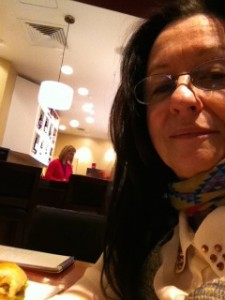
“And why are you about blowing your horn? It’s a bit rude.”
“I’ve been held up the whole way. These people need to get to the airport.”
“Well we have a woman over here having a baby. We needed to get her to hospital. You don’t need to be blowing your horn. You’d be better if you were more polite.”
Were the Irish police correcting people’s manners I thought with a smile?
We zipped along the last miles to Dublin to the seven and a half hour flight back to Boston. Now how long had I been gone? I couldn’t remember but the plane reservations made it a week.
I had lost time.
